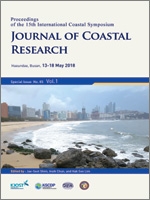Barboza, E.G.; Rosa, M.L.C.C.; Dillenburg, S.R.; Watanabe, D.S.Z.; Esteves, T.; Martins, E.M., and Gruber, N.L.S., 2018. Diachronic Condition Between Maximum Transgressive and Maximum Eustatic Sea-Level in Holocene: Subsidies for Coastal Management. In: Shim, J.-S.; Chun, I., and Lim, H.S. (eds.), Proceedings from the International Coastal Symposium (ICS) 2018 (Busan, Republic of Korea). Journal of Coastal Research, Special Issue No. 85, pp. 446–450. Coconut Creek (Florida), ISSN 0749-0208.
The coastline of Pelotas Basin/Brazil displays alternate sectors showing long-term conditions of erosion and accretion during the Holocene, corresponding to retrogradational/transgressive and progradational/regressive barriers respectively. Currently, the retrogradational/transgressive sectors are suffering from problems related to coastal erosion, generating problems for the public and private sectors. Thus, it is important to understand if coastal sectors suffer long-term erosion. The transition between a retrogradational/transgressive and a progradational/regressive barrier is still not well known, and this is the reason why some GPR (Ground Penetrating Radar) profiles and a drilling were performed in the transition region between the two basic types of barriers that occur at São José do Norte/RS/Brazil. Six radarfacies of aeolian, lagoon and backshore/foreshore, upper/lower shoreface deposits were identified, and, also, the subsurface transition, between a transgressive phase and a regressive phase of the barrier was identified. In the transition, reflectors of a paleochannel and a delta system were interpreted as corresponding to active channel systems during the last glaciation, which was then partially reworked during the final stages of the postglacial marine transgression. The barrier at São José do Norte changed from retrogradational/transgressive to a progradational/regressive phase before the maximum eustatic sea-level which occurred at about 5.6 ka, defining a diachronic condition of the maximum transgression identified in the GPR record and dated by 14C at 6,652 – 6,424 yr cal BP. Based on these results, the area is considered to have a long-term progradational behavior. The identification of deposits with conditions of erosion and accretion in the subsurface gives important information to the understanding of the coastal evolution of Pelotas Basin and contributing to coastal management by identifying the long-term behavior of this sector.





